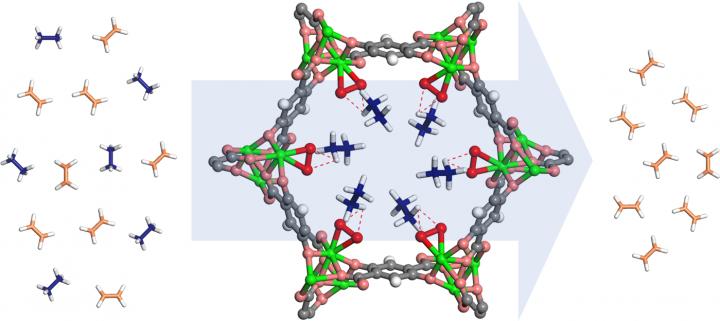Of all the hydrocarbons composing crude oil, ethylene is one of the most valued by industry. With a low molecular weight and relatively simple structure, it’s an unassuming compound, but contains one crucial feature: a double-bond between its two carbon atoms, which can be broken to attach other atoms and groups. This makes it a basic building block for many more complex hydrocarbon structures, including the common polymer polyethylene.

However, separating ethylene from the complex mixture that is crude oil is a costly business, requiring the crude to be chilled below -100°C. Ethylene can be produced by “cracking” larger molecules using heat, steam and catalysts, but this is also a costly process. Finding a cheaper way of obtaining ethylene directly from crude has been a major goal for the hydrocarbons industry for many years.
Researchers from the University of Texas San Antonio (UTSA) and China’s Taiyuan University of Technology have announced a step forward in this search in the current issue of Science. Working with a team at the US National Institute of Standards and Technology Centre for Neutron Research, the chemists have been studying materials known as metal-organic frameworks (MOFs). These consist of a framework of organic chains joined together with metal atoms, usually iron, which is “decorated” with more organic groups. MOFs have been of interest to the plastics and petroleum industry for some time because their ability to separate individual hydrocarbons from complex mixtures.
Up to now, however, ethylene separation has proved an elusive goal. The major components of crude oil are ethylene and ethane, a related molecule with no double-bond. "Most MOFs that have been studied grab onto ethylene rather than ethane. A few of them have even demonstrated excellent separation performance, by selectively adsorbing the ethylene,” said Wei Zhou, a member of the team at NCNR. “But from an industrial perspective you would prefer to do the opposite if feasible. You want to adsorb the ethane byproduct and let the ethylene pass through."
The NCNR’s team’s attention turned to a particular MOF, known as MOF-74, in 2012. This has shown the potential for separating ethylene, and the team took inspiration from biochemistry to improve its performance.
In all organic chemistry, an important way of building new molecules is to break the strong bond between carbon and hydrogen. In biochemistry, this is done by complex proteins called enzymes, and enzymes which contain iron peroxide are particularly efficient at grabbing onto carbon-hydrogen bonds and breaking them.
The UTSA team experimented with modifying the walls of MOF-74, which resembles the frame of a skyscraper, to include iron peroxide groups similar to those found in enzymes that can break the C-H bond. Passing crude oil over this modified MOF, they found that it attracted and bound ethane, which contains six C-H bonds, very strongly. The team at NCNR determined which parts of the structure is responsible for attracting ethane, which may make the compound even more versatile.
"Without the fundamental understanding of the mechanism, no one would believe our results," said Prof Banglin Chen, who led the UTSA team. "We also think that we can try to add other small groups to the surface, maybe do other things. It's a whole new research direction and we're very excited."




Poll: Should the UK’s railways be renationalised?
I'd hate to be disingenuous so I've replotted the data with the first trendline from 1946 to 1977 and the second using your chosen dates 1983 to 2018....